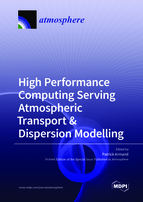High Performance Computing Serving Atmospheric Transport & Dispersion Modelling
A special issue of Atmosphere (ISSN 2073-4433). This special issue belongs to the section "Atmospheric Techniques, Instruments, and Modeling".
Deadline for manuscript submissions: closed (30 May 2021) | Viewed by 41641
Special Issue Editor
Interests: atmospheric transport and dispersion; chemistry and transport coupling; health and environment impact; meso-scale; local scale; downscaling; 3D modelling; 3D simulation; high performance computing; emergency preparedness and response
Special Issues, Collections and Topics in MDPI journals
Special Issue Information
Dear Colleagues,
The beginning of this century has witnessed both significant improvements of the physical and mathematical models dedicated to atmospheric transport & dispersion (AT&D) and the tremendous development of high perfomance computing (HPC) based on a large number of CPU/GPU processors. As substantial computational resources become more and more available and accessible, this Special Issue of Atmosphere focuses on the use of HPC in the field of high resolution multiscale ensemble AT&D simulations on larger and larger calculation domains. We invite scientists to contribute with original research articles and review articles including future lines of investigations. Topics of interest explore, but are not limited to:
- HPC for Large-Eddy Simulation and Direct Numerical Simulation of AT&D
- Benefit of HPC on GPU processors for AT&D modelling and simulation
- New benefit of HPC for data assimilation in Numerical Weather Prediction and AT&D modelling and simulation
- Accounting for multiple sources of uncertainty in AT&D modelling with HPC using ensemble approach or other approaches
- HPC for downscaling and upscaling AT&D simulations with applications to air pollution, air quality, and the climate change
- Benefit of HPC to AT&D modelling in Decision-Support Systems devoted to natural or anthropogenic hazards
Dr. Patrick Armand
Guest Editor
Manuscript Submission Information
Manuscripts should be submitted online at www.mdpi.com by registering and logging in to this website. Once you are registered, click here to go to the submission form. Manuscripts can be submitted until the deadline. All submissions that pass pre-check are peer-reviewed. Accepted papers will be published continuously in the journal (as soon as accepted) and will be listed together on the special issue website. Research articles, review articles as well as short communications are invited. For planned papers, a title and short abstract (about 100 words) can be sent to the Editorial Office for announcement on this website.
Submitted manuscripts should not have been published previously, nor be under consideration for publication elsewhere (except conference proceedings papers). All manuscripts are thoroughly refereed through a single-blind peer-review process. A guide for authors and other relevant information for submission of manuscripts is available on the Instructions for Authors page. Atmosphere is an international peer-reviewed open access monthly journal published by MDPI.
Please visit the Instructions for Authors page before submitting a manuscript. The Article Processing Charge (APC) for publication in this open access journal is 2400 CHF (Swiss Francs). Submitted papers should be well formatted and use good English. Authors may use MDPI's English editing service prior to publication or during author revisions.
Keywords
- Atmospheric transport and dispersion
- High performance computing
- Multiscale modelling
- Ensemble approach
- Data assimilation
- Uncertainty in AT&D






